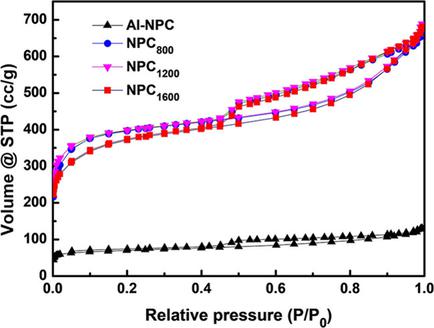当前位置:
X-MOL 学术
›
Electroanalysis
›
论文详情
Our official English website, www.x-mol.net, welcomes your feedback! (Note: you will need to create a separate account there.)
Applying Co3 O4 @nanoporous Carbon to Nonenzymatic Glucose Biofuel Cell and Biosensor
Electroanalysis ( IF 3 ) Pub Date : 2018-01-18 , DOI: 10.1002/elan.201700719 Kailong Jiao 1 , Zepeng Kang 1 , Bing Wang 2 , Shuqiang Jiao 1 , Yu Jiang 3 , Zongqian Hu 4
Electroanalysis ( IF 3 ) Pub Date : 2018-01-18 , DOI: 10.1002/elan.201700719 Kailong Jiao 1 , Zepeng Kang 1 , Bing Wang 2 , Shuqiang Jiao 1 , Yu Jiang 3 , Zongqian Hu 4
Affiliation

|
A novel hierarchically nanoporous carbon (NPC) derived from Al-based porous coordination polymer is prepared by two-step carbonization method for immobilization of the Co3O4 in the application of the nonenzymatic biofuel cells and biosensors. The structure and morphology are characterized by scanning electron microscopy (SEM), transmission electron microscopy (TEM), high-resolution transmission electron microscopy (HRTEM), and X-ray diffraction (XRD). Brunauer-Emmett-Teller (BET) is to characterize the porous nature of the NPC, and X-ray photoelectron spectroscopy (XPS) is to characterize the composition of Co3O4@nanoporous carbon (Co3O4@NPC). Without collapse in the high carbonization temperature (above 1600 degrees C), the NPC maintains the nanoporous structure and high specific surface area of 1551.2m(2)g(-1). In addition, the NPC is composited with Co3O4 by hydrothermal method to form the Co3O4@NPC. When tested as the nonenzymatic electrocatalyst for glucose oxidation reaction (GOR), the Co3O4@NPC exhibits higher response to glucose, in which the current shifts up by 64%, than pure Co3O4 in 0.1M KOH. The limit of detection is 0.005mM (S/N=3) and response time is within 3s. The detection range can be divided into two sections of 0.02-1.4mM and 1.4-10.7mM with the sensitivity of 249.1AmM(-1)cm(-2) and 66.6AmM(-1)cm(-2), respectively. A glucose fuel cell is constructed with the Co3O4@NPC as the anode and Pt/C catalyst as the cathode. The open-circuit potential of the nonenzymatic glucose/O-2 fuel cell was 0.68V, with a maximum power density of 0.52mWcm(-2) at 0.27V. This work may contribute to exploring other nanoporous carbons for application in glucose fuel cells and biosensors.
中文翻译:

将 Co3 O4 @纳米多孔碳应用于非酶葡萄糖生物燃料电池和生物传感器
通过两步碳化法制备了一种源自铝基多孔配位聚合物的新型分层纳米多孔碳 (NPC),用于将 Co3O4 固定在非酶生物燃料电池和生物传感器中。通过扫描电子显微镜 (SEM)、透射电子显微镜 (TEM)、高分辨率透射电子显微镜 (HRTEM) 和 X 射线衍射 (XRD) 对其结构和形貌进行表征。Brunauer-Emmett-Teller(BET)是表征NPC的多孔性质,X射线光电子能谱(XPS)是表征Co3O4@纳米多孔碳(Co3O4@NPC)的组成。没有崩溃的高碳化温度(1600 摄氏度以上),NPC 保持纳米多孔结构和 1551.2m(2)g(-1) 的高比表面积。此外,NPC 通过水热法与 Co3O4 复合形成 Co3O4@NPC。当作为葡萄糖氧化反应 (GOR) 的非酶电催化剂进行测试时,Co3O4@NPC 对葡萄糖表现出更高的响应,其中电流比在 0.1M KOH 中的纯 Co3O4 高 64%。检测限为0.005mM(S/N=3),响应时间在3s以内。检测范围可分为0.02-1.4mM和1.4-10.7mM两段,灵敏度分别为249.1AmM(-1)cm(-2)和66.6AmM(-1)cm(-2)。葡萄糖燃料电池以 Co3O4@NPC 为阳极,Pt/C 催化剂为阴极。非酶葡萄糖/O-2燃料电池的开路电位为0.68V,0.27V时的最大功率密度为0.52mWcm(-2)。
更新日期:2018-01-18
中文翻译:

将 Co3 O4 @纳米多孔碳应用于非酶葡萄糖生物燃料电池和生物传感器
通过两步碳化法制备了一种源自铝基多孔配位聚合物的新型分层纳米多孔碳 (NPC),用于将 Co3O4 固定在非酶生物燃料电池和生物传感器中。通过扫描电子显微镜 (SEM)、透射电子显微镜 (TEM)、高分辨率透射电子显微镜 (HRTEM) 和 X 射线衍射 (XRD) 对其结构和形貌进行表征。Brunauer-Emmett-Teller(BET)是表征NPC的多孔性质,X射线光电子能谱(XPS)是表征Co3O4@纳米多孔碳(Co3O4@NPC)的组成。没有崩溃的高碳化温度(1600 摄氏度以上),NPC 保持纳米多孔结构和 1551.2m(2)g(-1) 的高比表面积。此外,NPC 通过水热法与 Co3O4 复合形成 Co3O4@NPC。当作为葡萄糖氧化反应 (GOR) 的非酶电催化剂进行测试时,Co3O4@NPC 对葡萄糖表现出更高的响应,其中电流比在 0.1M KOH 中的纯 Co3O4 高 64%。检测限为0.005mM(S/N=3),响应时间在3s以内。检测范围可分为0.02-1.4mM和1.4-10.7mM两段,灵敏度分别为249.1AmM(-1)cm(-2)和66.6AmM(-1)cm(-2)。葡萄糖燃料电池以 Co3O4@NPC 为阳极,Pt/C 催化剂为阴极。非酶葡萄糖/O-2燃料电池的开路电位为0.68V,0.27V时的最大功率密度为0.52mWcm(-2)。



























 京公网安备 11010802027423号
京公网安备 11010802027423号